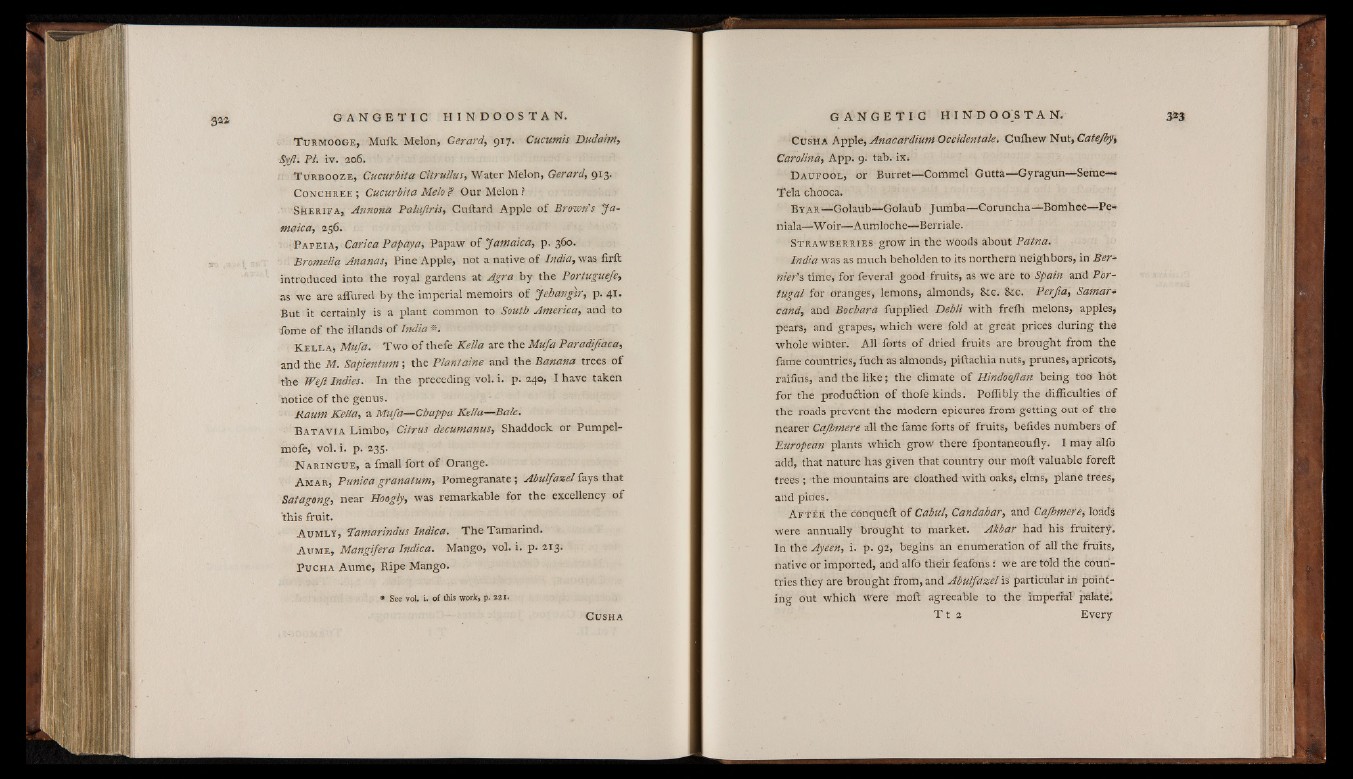
T urmooge, Muik Melon» Gerard, 917. Cucumis Dudaitn,
Syji. PI. iv. 206.
; T u rbooze, Cucurbit a Citrullus, Water Melon» Gerard, 913.
Conchree ; Cucurbita Melo ? Our Melon ?
Sh erifa, Annona Palujlris, Cuftard Apple of Brown's Jamaica,
236.
Pa p e ia , Carica Papaya, Papaw of Jamaica, p. 360.
Bromelia Ananas, Pine Apple, not a native o f India,-was firlt
introduced into the royal gardens at Agra by the Portuguefe,
as we are affured by the imperial memoirs of Jebangir, p. 41.
But it certainly is a plant common to South America, and to
ibme o f the iflands of India
K e l l a, Mufa. Two of thefe Kella are the Mufa Paradijiaca,
and the M. Sapientum; the Plantaine and the Banana trees of
the Weji Indies. In the preceding vol. i. p. 240, I have taken
notice of the genus.
Baum Kella, a Mufa— Chappa Kella—Bale.
B a t a v ia Limbo, Citrus decumanus, Shaddock or Pumpel-
mbfe, vol. i. p. 235.
N a r in g u e , a fmall fort of Orange.
Amar, Punicagranatum, Pomegranate; Abulfazelfays that
Satagong, near Hoogly, was remarkable for the excellency of
this fruit.
A um ly, Tamarindus Indica. The Tamarind.
Aitme, Mangifera Indica. Mango, vol. i. p. 213.
P u c h a Aume, Ripe Mango.
* See vol. i. of this work, p. 221.
CU SH A
C u s h a Apple, Anacardium Occidentale. Cuihew Nut, Catejby,
Carolina, App. 9. tab. ix.
D a u f o o l , or Burret— Cornmel Gutta— Gyragun— Seme—
Tela chooca.
By AR — Golaub— Golaub Jumba —Coruncha —Bomhee— Pe-
niala—Woir— Aumloche—Berriale.
Strawberries grow in the woods about Patna.
India was as much beholden to its northern neighbors, in Bernier's
time, for feveral good fruits, as we are to Spain and Pbr-
tugal for oranges, lemons, almonds, Sec. See. Perjia, Samar-
cand, and Bocbara fupplied Debli with frelh melons, apples,
pears, and grapes, which were fold at great prices during the
whole winter. All forts of dried fruits are brought from the
fame countries, fuch as almonds, piftachia nuts, prunes, apricots,
raiflns, and the like; the climate o f Hindoo/Ian being too hot
for the produftion of thofe kinds; Poffibly the difficulties o f
the roads prevent the modern epicures from getting out o f the
nearer Cajhmere all the fame forts of fruits, befides numbers of
European plants which grow there fpontaneouily. I may alfo
add, that nature has given that country our moil valuable foreft
frees ; the mountains are cloathed with oaks,- elms, plane trees,
and pin'es.
A f TES. the conqueft o f Cabul, Candahar, and Cajhmere, loads
were annually brought to market. Akbar had his fruitery.
In the Ayeen, i. p. 92, begins an enumeration of all the fruits,
native or imported, and alfo their feafons.' we are told the countries
they are brought from, and AbulfdzeVxi particular in pointing
out which Were moil agreeable to the imperial palate,
T t 2 Every